Experimental Investigation of Oil Transport during Low Load to High Load Transient in Internal Combustion Engines
Abstract
:1. Introduction
2. Experimental Setup
2.1. Engine and Optical Setup
2.2. Test Procedure
3. Results: Spike of LOC When Changing from Low Load to High Load
4. Discussion
4.1. Mechanism of Spike Oil Leakage
4.1.1. Bridging Oil in the Second Land to the Liner
4.1.2. Oil Pushed to Liner through the Gap
4.1.3. Opened Upper Flank of Ring Groove Interface
4.2. Dependency of Speed and Load
4.2.1. The Character Change across the Blowby Separation Line
4.2.2. The Effect of Engine Speed
4.3. Time Duration at Low Load
4.4. The Elimination of Spike Oil Leakage
4.4.1. Operation: Gradually Increase the Engine Load
4.4.2. Path to the Liner and Piston Land
5. Conclusions
Author Contributions
Funding
Data Availability Statement
Acknowledgments
Conflicts of Interest
Nomenclature
| LOC | Lubricating Oil Consumption |
| 2D-LIF | 2D Laser Induced Fluorescence |
| OCR | Oil Control Ring |
| TPOCR | Three-Piece Oil Control Ring |
| OE | Oil Emission |
| SI | Spark Ignited |
| PM | Particulate Mass |
| PN | Particulate Number |
| GPF | Gasoline Particulate Filter |
| DPF | Diesel Particulate Filter |
| RDE | Real Driving Emission |
| WOT | Wide Open Throttle |
| BDC | Bottom Dead Center |
| TDC | Top Dead Center |
| FPGA | Field-Programmable Gate Array |
References
- Cheng, W.K.; Hamrin, D.; Heywood, J.B.; Hochgreb, S.; Min, K.; Norris, M. An Overview of Hydrocarbon Emissions Mechanisms in Spark-Ignition Engines. SAE Technical Paper 932708. 1993. [Google Scholar] [CrossRef]
- Mayer, A.; Czerwinski, J.; Kasper, M.; Ulrich, A.; Mooney, J.J. Metal Oxide Particle Emissions from Diesel and Petrol Engines. Technical Paper 2012-01-0841. 2012. [Google Scholar] [CrossRef]
- Leach, F.; Chapman, E.; Jetter, J.J.; Rubino, L.; Christensen, E.D.; John, P.C.S.; Fioroni, G.M.; McCormick, R.L. A Review and Perspective on Particulate Matter Indices Linking Fuel Composition to Particulate Emissions from Gasoline Engines. SAE Int. J. Fuels Lubr. 2021, 15, 3–28. [Google Scholar] [CrossRef]
- Jonson, J.E.; Borken-Kleefeld, J.; Simpson, D.; Nyíri, A.; Posch, M.; Heyes, C. Impact of excess NO x emissions from diesel cars on air quality, public health and eutrophication in europe. Environ. Res. Lett. 2017, 12, 094017. [Google Scholar] [CrossRef]
- Premnath, V.; Khalek, I.; Morgan, P.; Michlberger, A.; Sutton, M.; Vincent, P. Effect of Lubricant Oil on Particle Emissions from a Gasoline Direct Injection Light-Duty Vehicle. SAE Technical Paper 2018-01-1708. 2018. [Google Scholar] [CrossRef]
- Schwanzer, P.; Schillinger, M.; Mieslinger, J.; Walter, S.; Hagen, G.; Märkl, S.; Haft, G.; Dietrich, M.; Moos, R.; Gaderer, M.; et al. A Synthetic Ash-Loading Method for Gasoline Particulate Filters with Active Oil Injection. SAE Int. J. Engines 2021, 14, 493–505. [Google Scholar] [CrossRef]
- Turnbull, R.; Dolatabadi, N.; Rahmani, R.; Rahnejat, H. An assessment of gas power leakage and frictional losses from the top compression ring of internal combustion engines. Tribol. Int. 2020, 142, 105991. [Google Scholar] [CrossRef]
- A Technical Summary of Euro 6/VI Vehicle Emission Standards. Available online: https://theicct.org/publication/a-technical-summary-of-euro-6-vi-vehicle-emission-standards/ (accessed on 1 July 2016).
- Li, M.; Tian, T. Effect of Blowby on the Leakage of the Three-Piece Oil Control Ring and Subsequent Oil Transport in Upper Ring-Pack Regions in Internal Combustion Engines. Lubricants 2022, 10, 250. [Google Scholar] [CrossRef]
- Przesmitzki, S.; Tian, T. Oil Transport Inside the Power Cylinder During Transient Load Changes; SAE Technical Paper 2007-01-1054. SAE Trans. 2007, 652–667. [Google Scholar] [CrossRef]
- Przesmitzki, S.; Tian, T. An Experimental Study of the Time Scales and Controlling Factors Affecting Drastic Blow-by Increases during Transient Load Changes in SI Engines. SAE Technical Paper 2008-01-0794. 2008. [Google Scholar] [CrossRef]
- Ahling, S.; Tian, T. Oil Transport Phenomena during extreme load transients inside the power cylinder unit as investigated by HS-2DLIF (High-Speed 2D Laser-Induced Fluorescence). SAE Technical Paper 2019-01-2363. 2019. [Google Scholar] [CrossRef]
- Yilmaz, E.; Thirouard, B.; Tian, T.; Wong, V.W.; Heywood, J.B.; Lee, N. Analysis of Oil Consumption Behavior during Ramp Transients in a Production Spark Ignition Engine. SAE Technical Paper 2001-01-3544. 2001; 1828–1837. [Google Scholar] [CrossRef]
- Papadopoulos, I.; Becker, S.; Ehnis, H.; Kunzel, R.; Frommer, A. Influence of Oil Drain Holes on Oil Emission of a Turbocharged Gasoline Engine. SAE Int. J. Engines 2017, 10, 1948–1953. [Google Scholar] [CrossRef]
- Uhlig, B.P.; Kirner, C.; Preuss, A.-C.; Wachtmeister, G. Real-Time Measurement of the Piston Ring Gap Positions and Their Effect on Exhaust Engine Oil Emission. SAE Technical Paper 2018-01-5006. 2018. [Google Scholar] [CrossRef]
- Adelmann, J.; Becker, S.; Rabute, R.; Bruno, R. Optimized oil control ring design for emission reduction. Zylinderlaufbahn Kolben Pleuel 2018, 91–103. [Google Scholar]
- Berthome, V.; Chalet, D.; Hetet, J.-F. Consequence of Blowby Flow and Idling Time on Oil Consumption and Particulate Emissions in Gasoline Engine. Energies 2022, 15, 8772. [Google Scholar] [CrossRef]
- Zanghi, E. Analysis of Oil Flow Mechanisms in Internal Combustion Engines via High Speed Laser Induced Fluorescence ( LIF ) Spectroscopy. Master’s Thesis, Massachusetts Institute of Technology, Cambridge, MA, USA, 2014. [Google Scholar]
- Zanghi, E.; Tian, T. Development of a High Speed Laser Induced Fluorescence (HSLIF) System in a Single Cylinder Engine for Oil Transport Studies. SAE Technical Paper 2016-01-0642. 2016; 1. [Google Scholar] [CrossRef]
- Ahling, S. Elements of Lubricant Transport Critical to Piston Skirt Lubrication and to Leakage into the Piston Ring Pack in Internal Combustion Engines. Ph.D. Thesis, Massachusetts Institute of Technology, Cambridge, MA, USA, 2021. [Google Scholar]
- Tian, T. Modeling the Performance of the Piston Ring-Pack in Internal Combustion Engines. Ph.D. Thesis, Massachusetts Institute of Technology, Cambridge, MA, USA, 1997. [Google Scholar]
- Zhong, X.; Li, M.; Tian, T. Hybrid digital twin for conditional lubricant oil transport simulation and oil consumption prediction in internal combustion engines. J. Eng. Tribol. 2023, 13506501221144697. [Google Scholar] [CrossRef]
- Przesmitzki, S. Characterization of Oil Transport in the Power Cylinder of Internal Combustion Engines during Steady State and Transient Operation. Ph.D. Thesis, Massachusetts Institute of Technology, Cambridge, CA, USA, 2018. [Google Scholar]



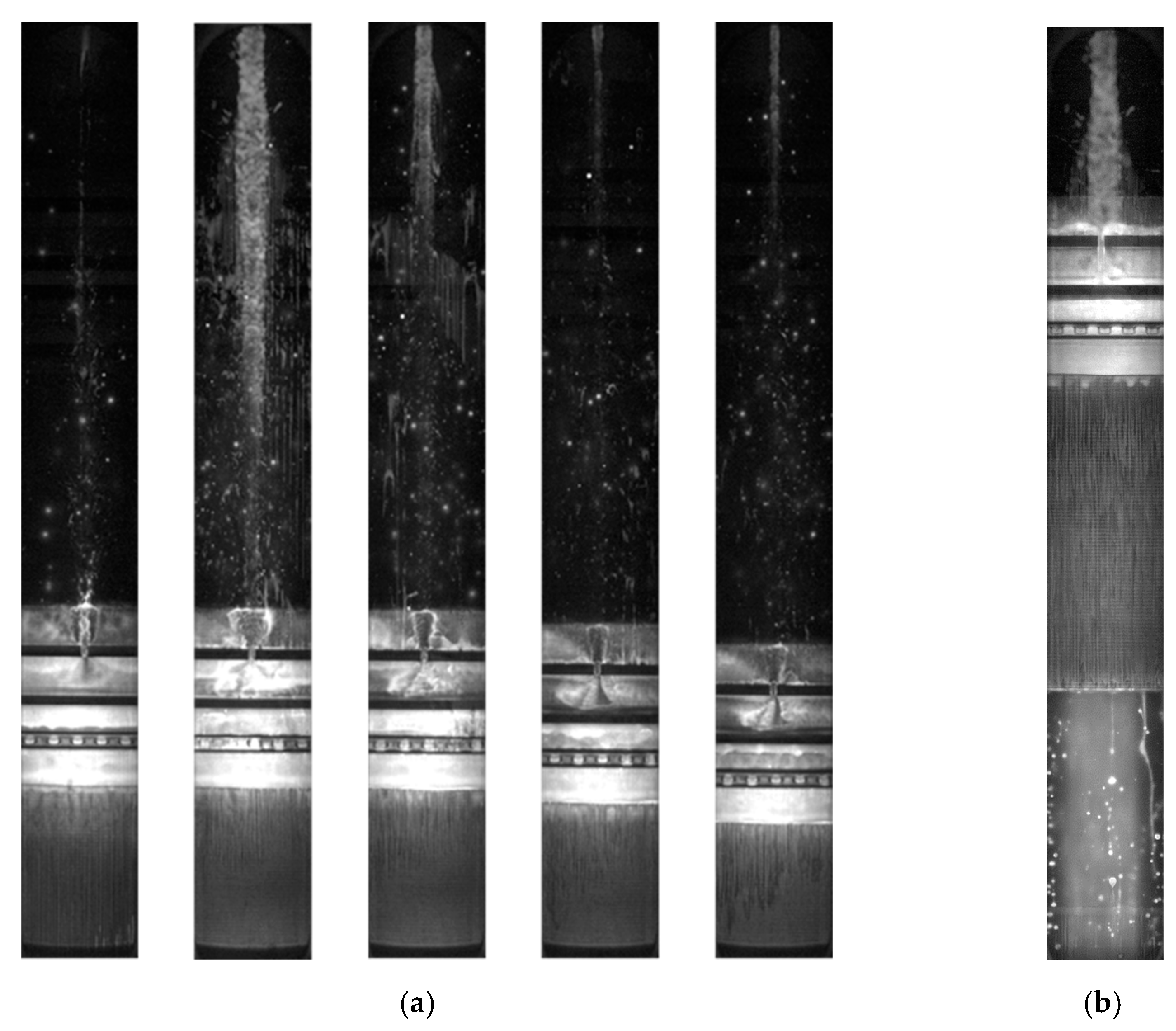
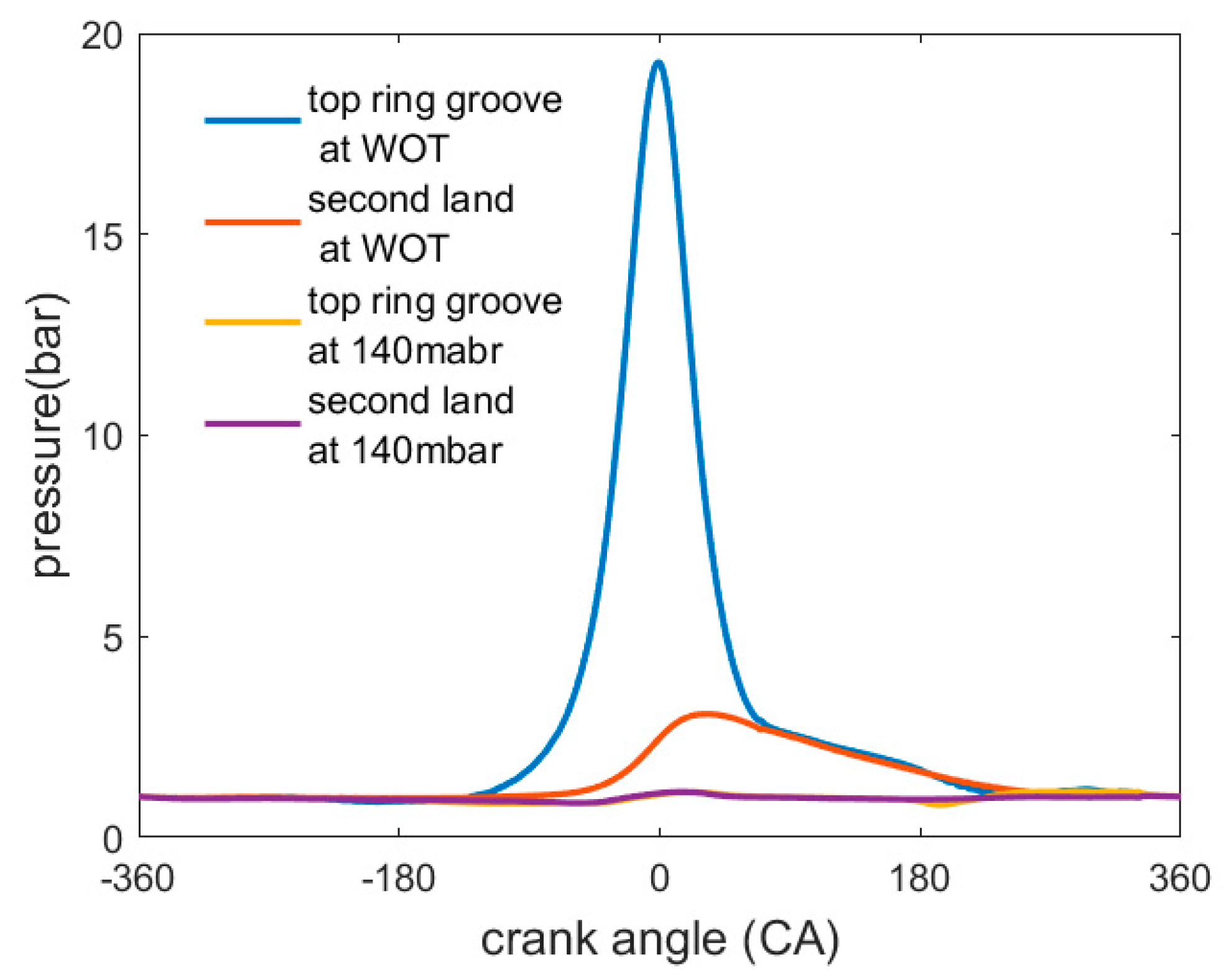

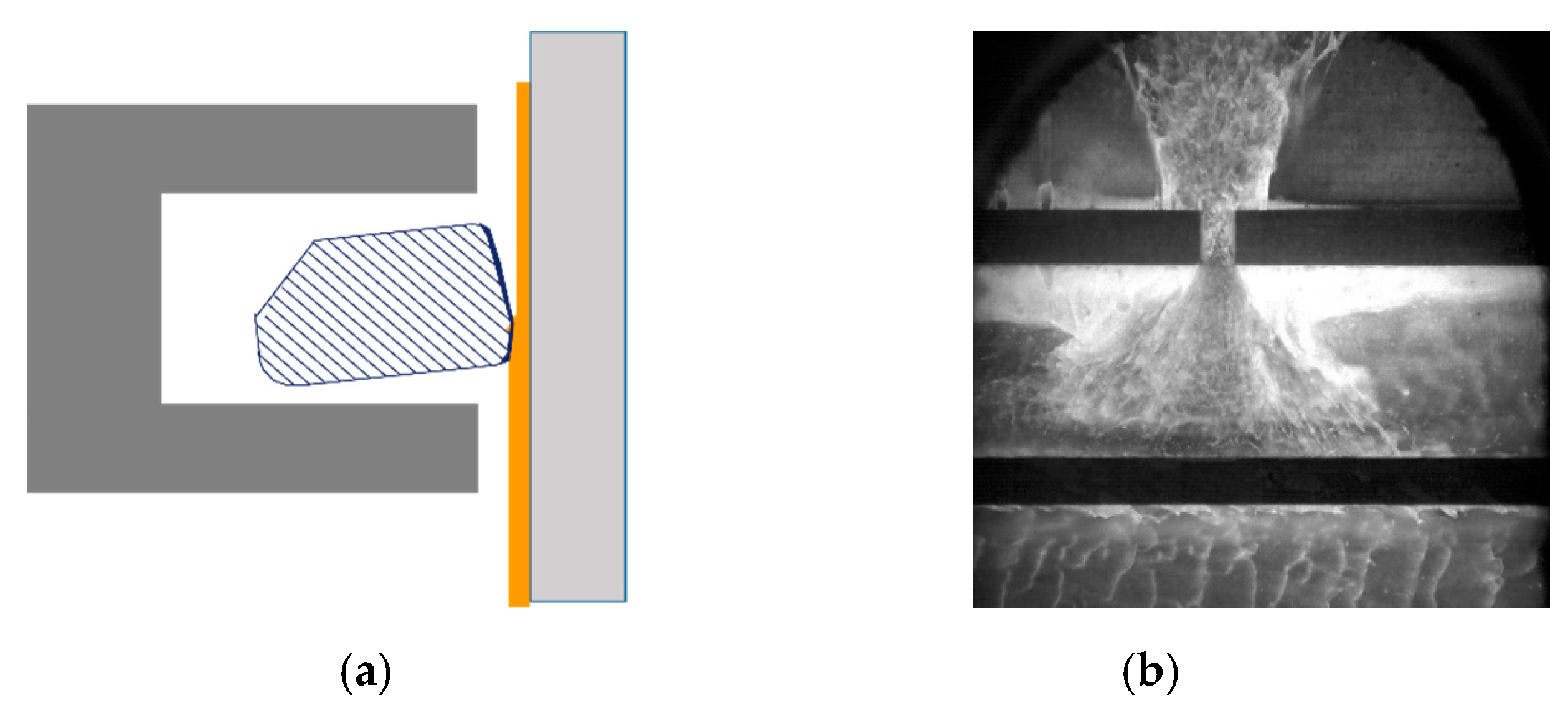
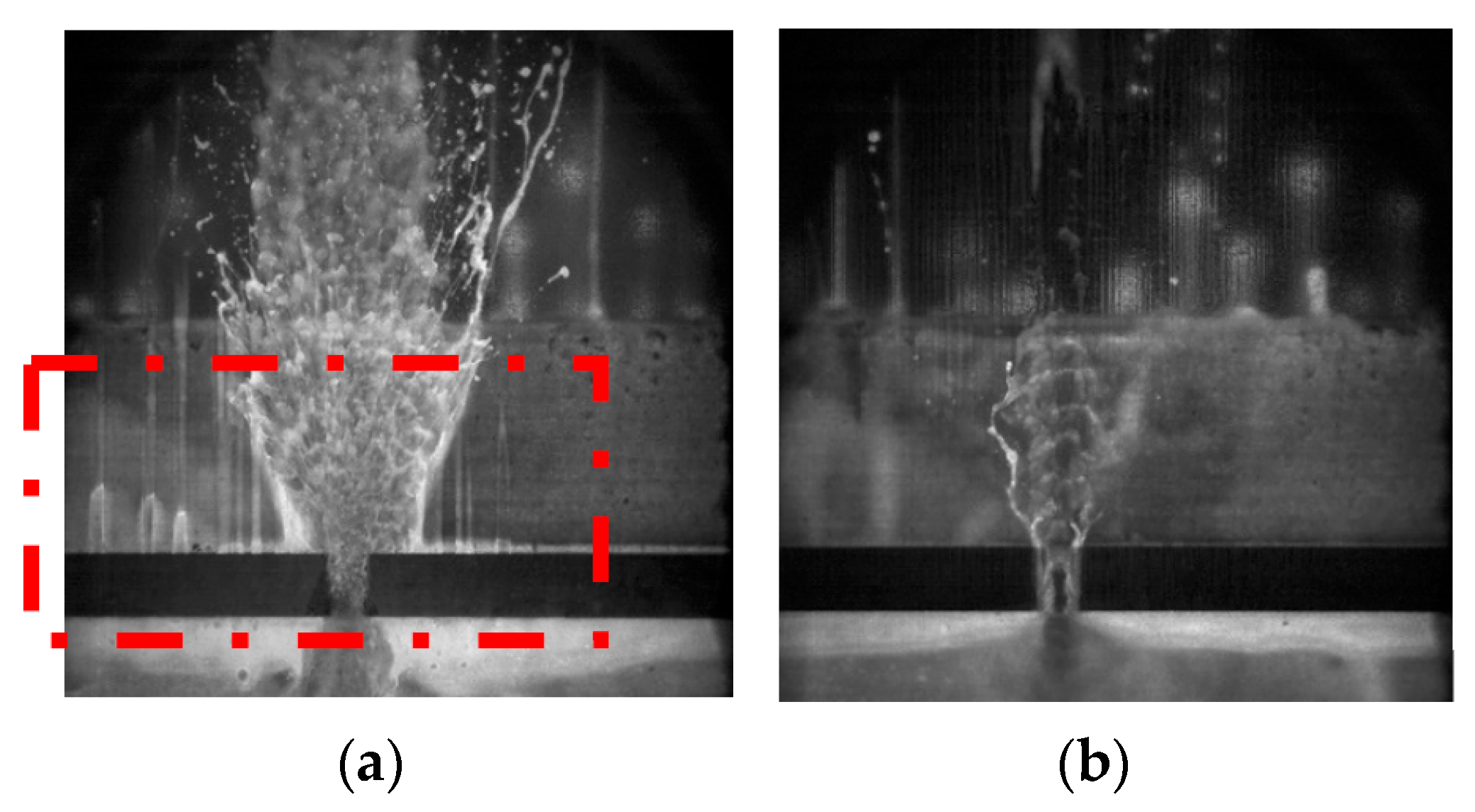
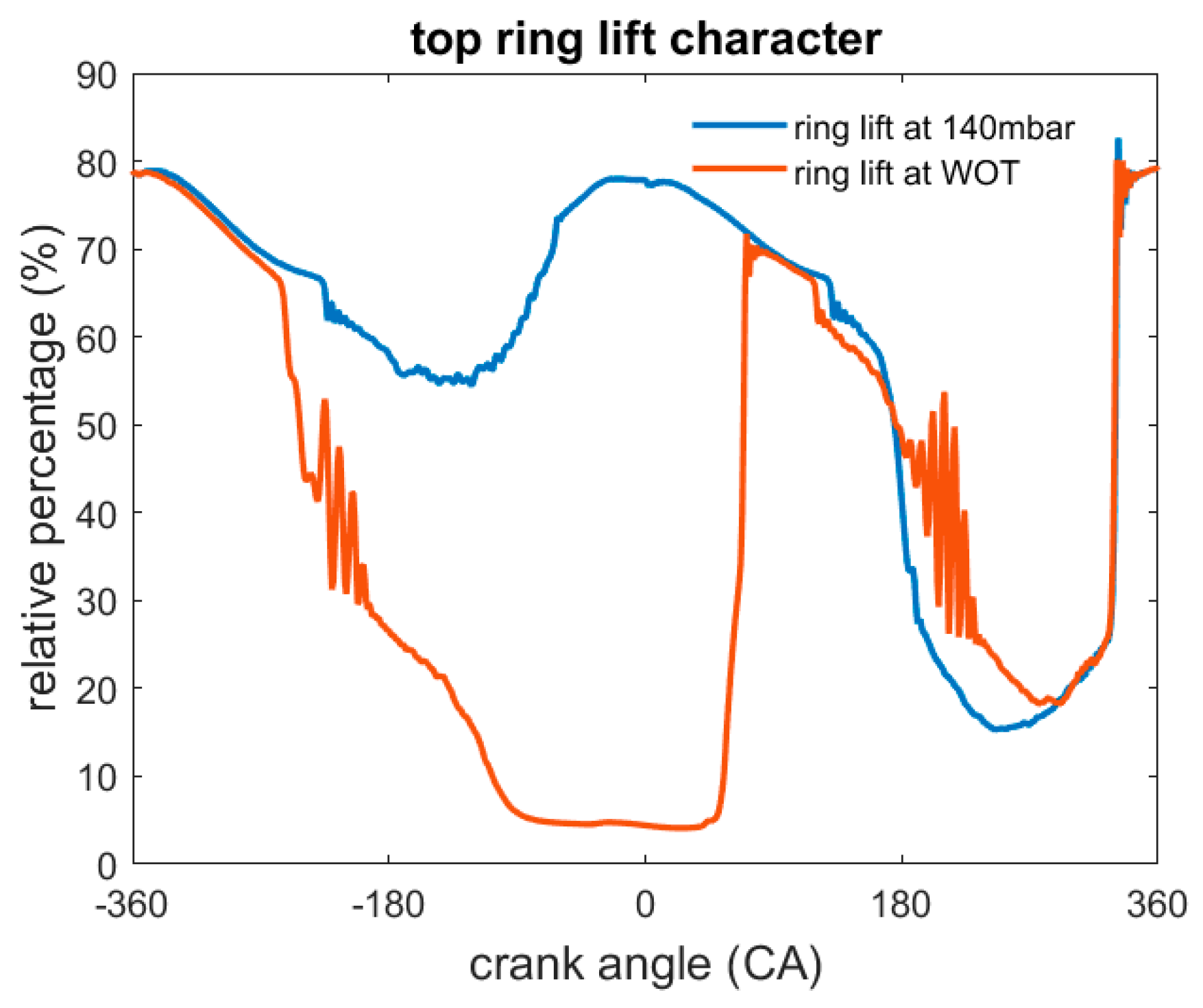
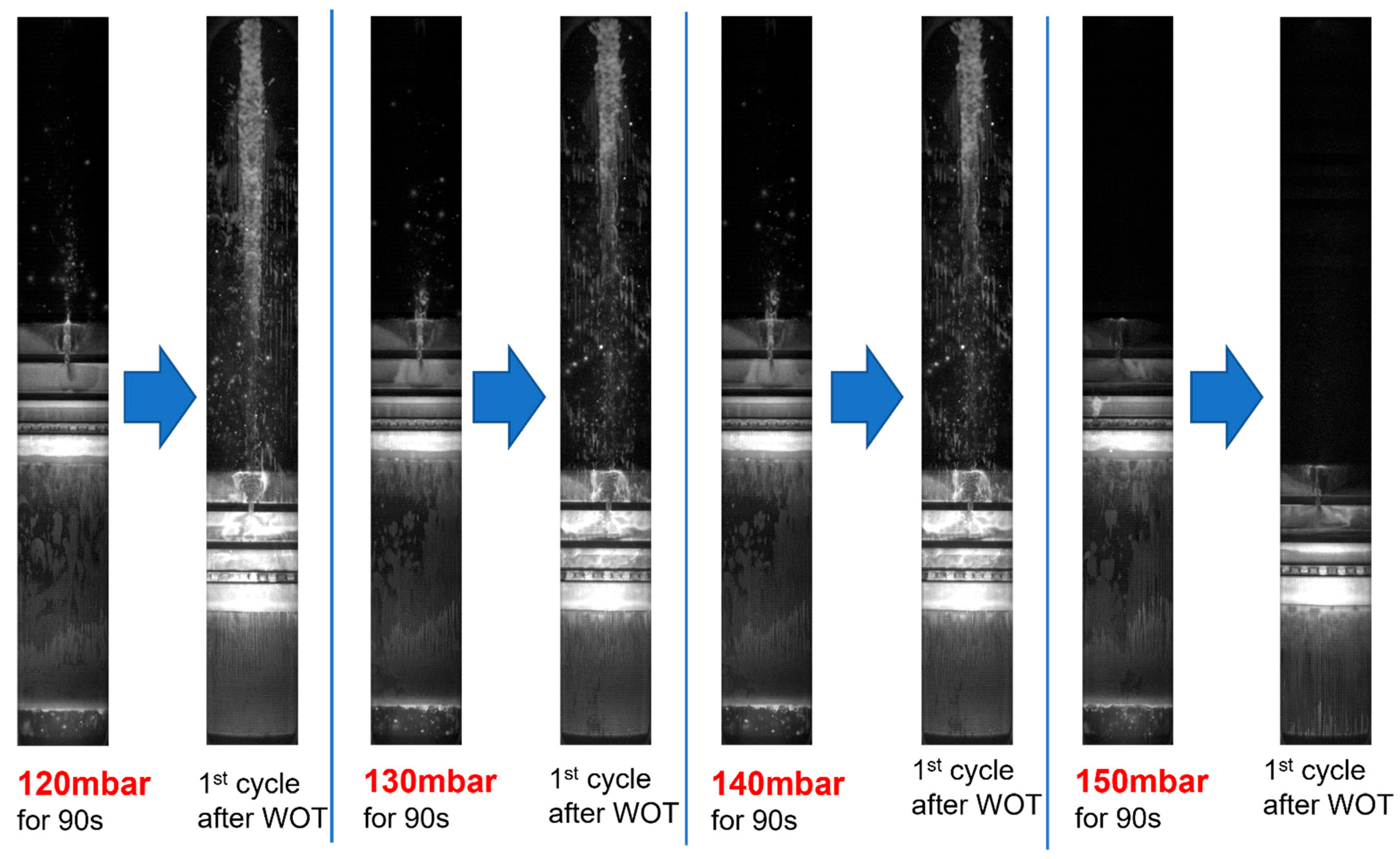

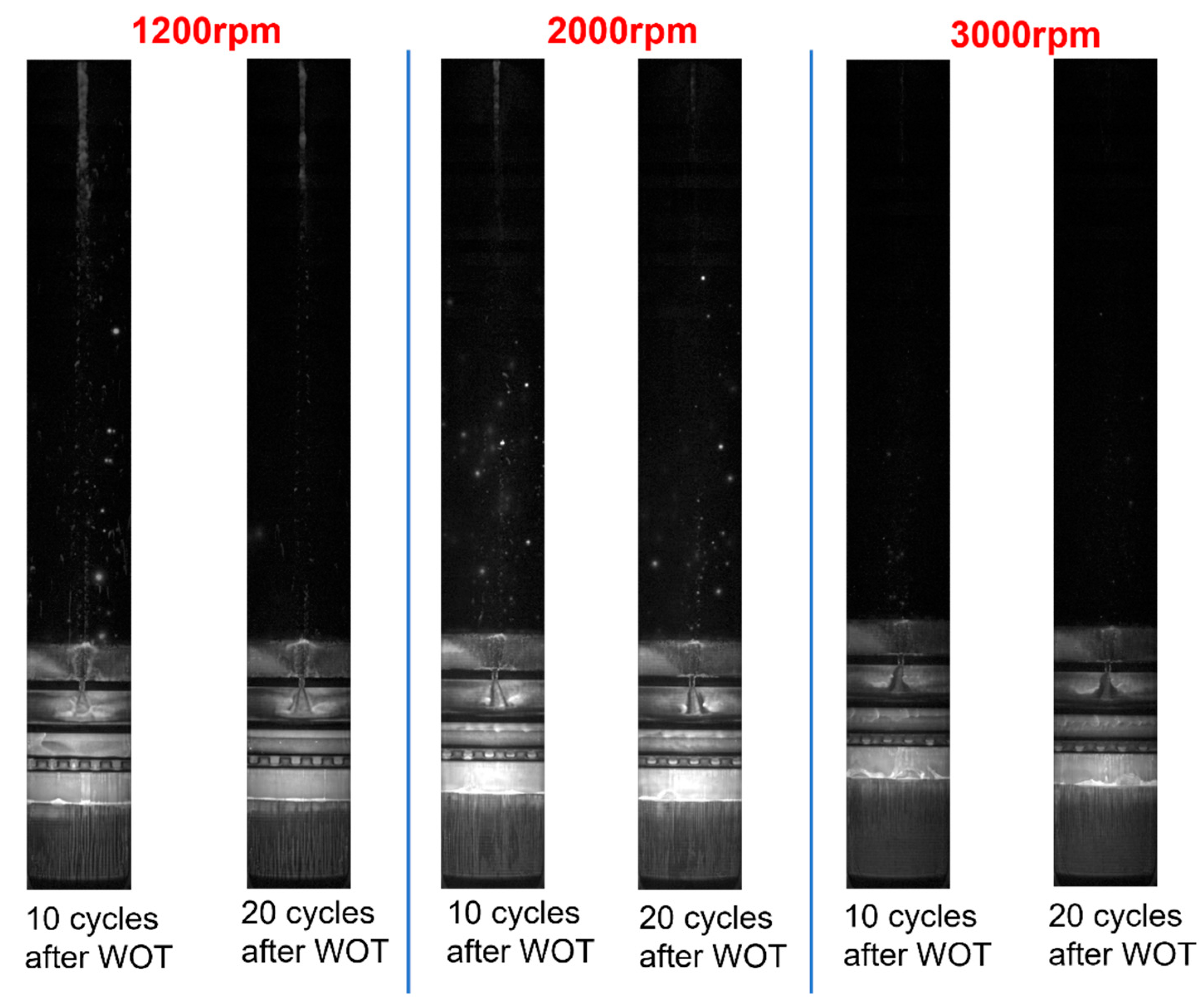
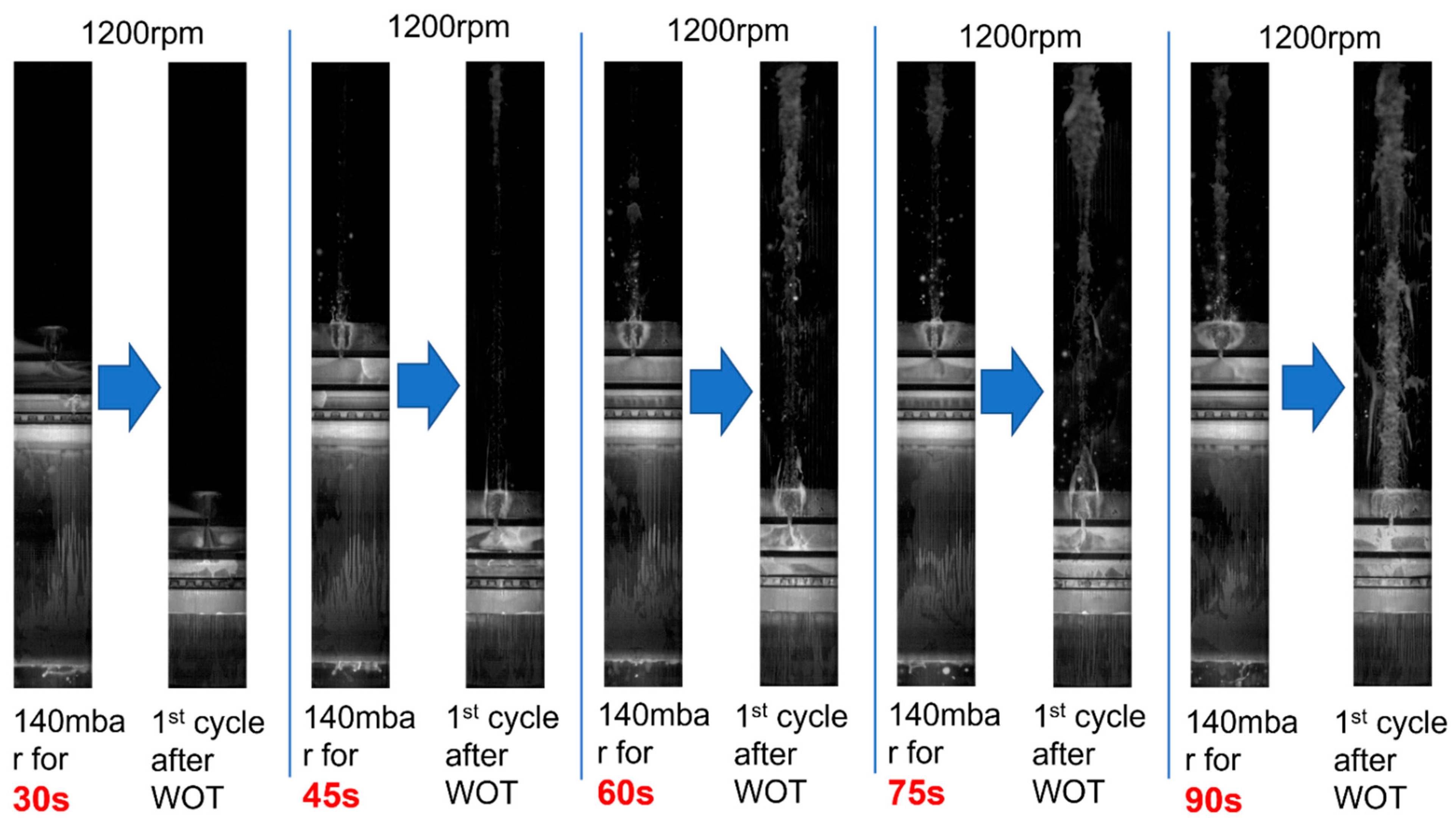

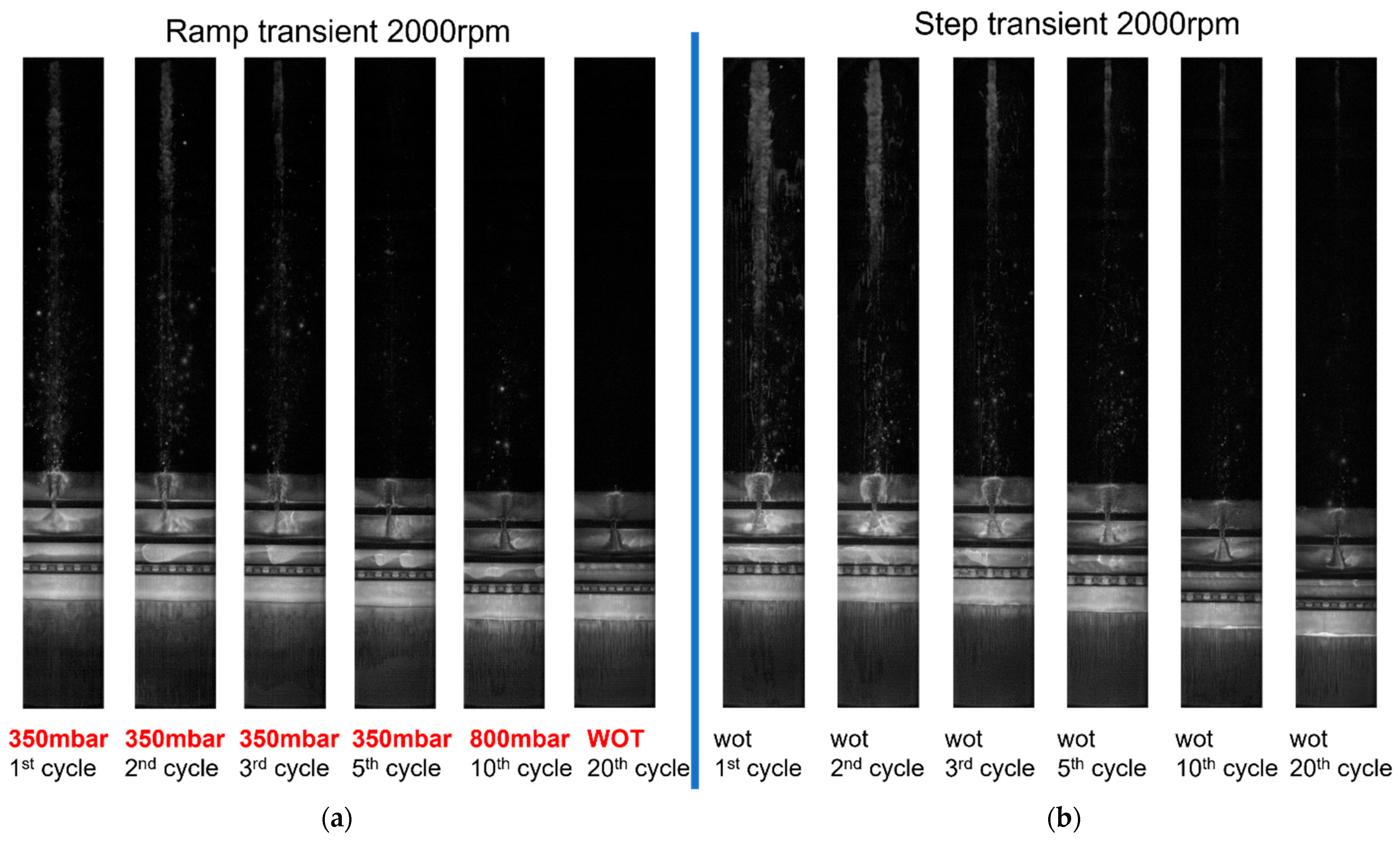



| Type | Spark Ignition 4 Valves |
| Bore | 86.6 mm |
| Stroke | 88.0 mm |
| Displacement | 0.511 L |
| Max specific power | 37.3 kW/L@5400 rpm |
| Max specific torque | 80 Nm/L@4200 rpm |
| Lubricant | SAE 0W20 |
Disclaimer/Publisher’s Note: The statements, opinions and data contained in all publications are solely those of the individual author(s) and contributor(s) and not of MDPI and/or the editor(s). MDPI and/or the editor(s) disclaim responsibility for any injury to people or property resulting from any ideas, methods, instructions or products referred to in the content. |
© 2023 by the authors. Licensee MDPI, Basel, Switzerland. This article is an open access article distributed under the terms and conditions of the Creative Commons Attribution (CC BY) license (https://creativecommons.org/licenses/by/4.0/).
Share and Cite
Li, M.; Tian, T. Experimental Investigation of Oil Transport during Low Load to High Load Transient in Internal Combustion Engines. Lubricants 2023, 11, 76. https://doi.org/10.3390/lubricants11020076
Li M, Tian T. Experimental Investigation of Oil Transport during Low Load to High Load Transient in Internal Combustion Engines. Lubricants. 2023; 11(2):76. https://doi.org/10.3390/lubricants11020076
Chicago/Turabian StyleLi, Mo, and Tian Tian. 2023. "Experimental Investigation of Oil Transport during Low Load to High Load Transient in Internal Combustion Engines" Lubricants 11, no. 2: 76. https://doi.org/10.3390/lubricants11020076





